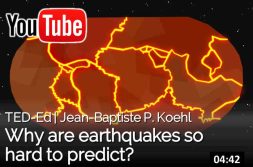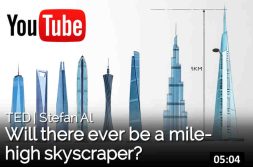Future
Questions
1. How often do you think about the future?
2. What do you hope for your own future?
3. What fears do you have for the future?
4. Where do you see yourself in ten, twenty and fifty years from now?
5. What will the world’s biggest problem be in the future?
6. Are you optimistic or pessimistic about the future? Why?
7. When you were younger, what did you think about your future?
8. What are some major changes the world will see in the future?
Videos
“My science fiction has different ancestors — African ones,” says writer Nnedi Okorafor. In between excerpts from her “Binti” series and her novel “Lagoon,” Okorafor discusses the inspiration and roots of her work — and how
[more]
she opens strange doors through her Afrofuturist writing.
[less]
Category: Education & Language | Geography & Travel
Take a look at the theories behind why earthquakes occur, what makes them so hard to predict and the warning system technologies we rely on today.
In 132 CE, Zhang Heng presented his latest invention: a large vase he claimed could tell them whenever an earthquake occurred for hundreds of miles. Today, we no longer rely on pots as warning systems, but earthquakes still offer challenges to those trying to track them. Why are earthquakes so hard to anticipate, and how could we get better at predicting them? Jean-Baptiste P. Koehl investigates.
Lesson by Jean-Baptiste P. Koehl, directed by Cabong Studios.
[more]
In 132 CE, Zhang Heng presented his latest invention: a large vase he claimed could tell them whenever an earthquake occurred for hundreds of miles. Today, we no longer rely on pots as warning systems, but earthquakes still offer challenges to those trying to track them. Why are earthquakes so hard to anticipate, and how could we get better at predicting them? Jean-Baptiste P. Koehl investigates.
Lesson by Jean-Baptiste P. Koehl, directed by Cabong Studios.
[less]
Category: Nature & Environment
Keywords: Future | Natural disasters
Would a mile-high skyscraper ever be possible? Explore the physics behind some of the tallest buildings and megastructures in the world.
In 1956, architect Frank Lloyd Wright proposed a mile-high skyscraper, a building five times as high as the Eiffel Tower. While this massive tower was never built, today bigger and bigger buildings are going up around the world. How did these impossible ideas turn into architectural opportunities? Stefan Al explains how these megastructures became fixtures of our city skylines.
Lesson by Stefan Al, directed by TED-Ed.
[more]
In 1956, architect Frank Lloyd Wright proposed a mile-high skyscraper, a building five times as high as the Eiffel Tower. While this massive tower was never built, today bigger and bigger buildings are going up around the world. How did these impossible ideas turn into architectural opportunities? Stefan Al explains how these megastructures became fixtures of our city skylines.
Lesson by Stefan Al, directed by TED-Ed.
[less]
Category: Art


